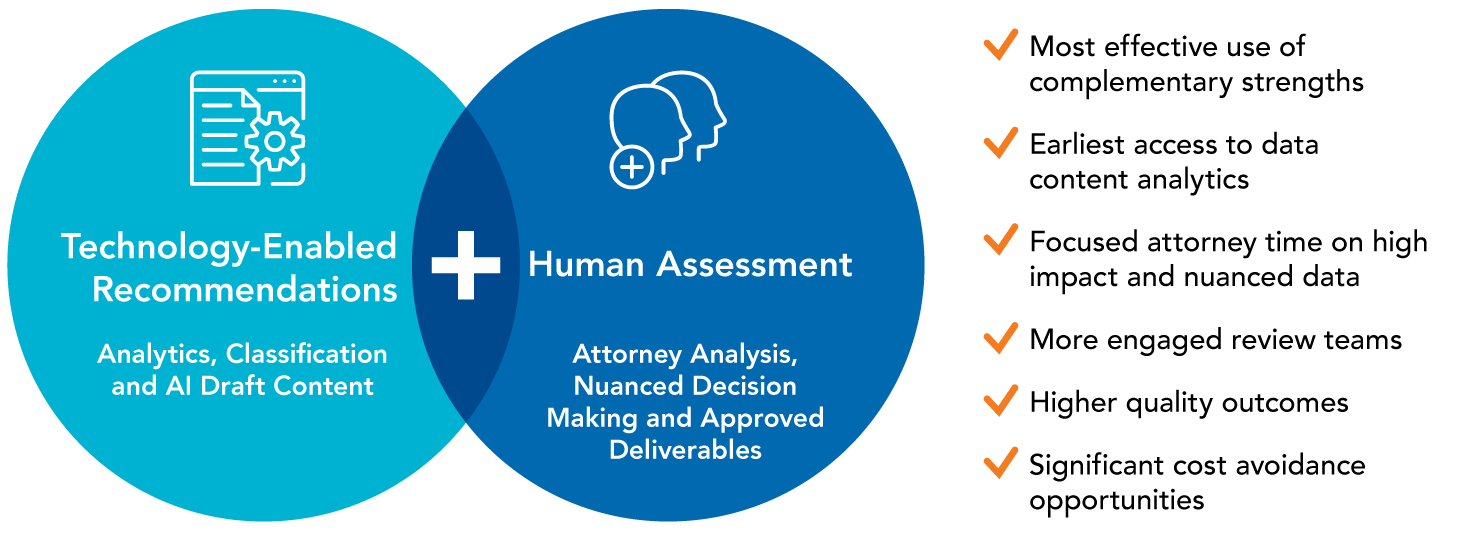
Why the Best Document Reviewers Are Supported by AI and Advanced Technology
January 26, 2024
|
By:
Document review is exceptionally challenging today. Data volumes continue to rise, modern data types require special handling, and risks of disclosing sensitive information are high. This places incredible stress on traditional review models, putting timelines, budgets, and accuracy at risk.
Advancements in AI and other technology can help reviewers work better and faster, but most organizations are barely scratching the surface.
How can legal teams take full advantage of technology? By applying it to what it does best: analytics, classification, and recommendations. Using technology to shoulder these burdens frees up review attorneys to focus on thoughtful analysis and nuanced decision making—which is what they do best.
Technology allows your legal team to look at the data holistically at the outset. This is critical to promote consistency and drive efficiency in the review. But market-leading technology now provides unprecedented early access to merits assessments—something that cannot be achieved through traditional batching, predictive reviews, concept culling, or search-based assessments.
With a healthy balance of people and tech, the strength of one complements the other, your review teams are set up for success. Overall, the balance looks like this:

Now that we have a basic framework, let’s take a closer look at each component.
Getting the most out of technology for doc review
What do we mean by analytics, classification, and recommendations? Modern technology-enabled review tools can go far beyond traditional Technology Assisted Review (TAR). In addition to enhancing capabilities of TAR predictions and communication matrices, tech can now:
- Supercharge traditional Early Case Assessment (ECA) into a powerful merits assessment of key data prior to any attorney document review
- Classify documents prior to starting review which are highly likely (or unlikely) to be: privilege, responsive, contain redactable material
- Identify, redact, and extract PII, PHI, and other sensitive information
- Automatically identify coding conflicts for focused resolution
- Perform broad sentiment analysis
- Create draft narratives or summaries including: privilege and redaction log entries, witness and key issue summaries, deposition and trial support data
When this technology is administered by the right team of experts they achieve impressive results. For example, when using technology to classify responsive sets, experienced providers routinely exceed 80% precision and recall.
Notably, investments in modern technology can be repurposed to drive additional value. Corporations can now create intelligent data reuse repositories. These include portable models of privileged relationships within their organizations in addition to classifications and redactions. This prior work can be used for subsequent investigations and litigations and be incorporated into an overall information governance framework.
Getting the best out of human reviewers
While the technology will provide great value, it should not be used in a vacuum. Human review, analysis, and sign-off on results is a critical component of the process. Focusing attorney review efforts strategically in conjunction with the technology will optimize results, priming outside and in-house counsel for success. Removing the mundane components of traditional doc review will result in a more engaged and productive review team—true for both contract reviewers and law firm review.
Human review is critical for both analysis and validation of the technology recommendations. Key areas requiring attorney review include:
Substantive review and analysis
- Performing substantive issue coding for content not easily identified by technology
- Making nuanced calls on privilege and responsiveness
- Overriding or certifying inconsistency flags
- Resolving QC anomalies
- Incorporating unanticipated facts that impact merit analysis
- Analysis of critical conversations, person-to-person shorthand, and timing of meetings and correspondence, particularly across different modern data types
- Assessing deep sentiment analysis
- Pivoting with evolving case strategy
Validation of technology
- Reviewing to fine-tune results and solidify classification models
- Refining tech-generated deliverables
- Validating tech results through statistical or stratified sampling
- Affirming defensibility of process
The benefits of hitting the right balance
Advanced technology can work for you, and then with you, as the case progresses. You can expect cost containment, and impactful opportunities for cost avoidance. Users of the most advanced tech will also gain back time in the process, shifting key insights to the beginning of the process instead of the end. This early insight may actually change the course of the investigation or litigation in your favor. Equally important, you will mitigate risk of inadvertent disclosure of sensitive, regulated, or privileged materials.
Implementing advanced analytics and AI enhanced document review across your data will provide your review team with actionable insight, clarity, and nimbleness in workflow that will enhance deliverables and better inform strategy. Technology recommendations validated by human review in one matter can be used on future matters and help support your overall information governance program.
In broader terms, technology helps reviewers rise above the drudgery of doc review and provide higher value outputs. The impact on productivity and engagement is as obvious as it is significant.
Need help finding the balance?
You shouldn’t have to be a technology expert in order to support your review team adequately—and with the right partner, you don’t have to be. Cut through the barrage of repetitive buzzwords and look for a service provider who will be:
- Transparent about how their tools work and what they do
- Clear about the tasks and benefits that review teams can expect
- Hands-on about answering your questions and deploying technology so that it serves your goals
Make sure you have the right mix of experts directing the technology (data scientists, linguists, statisticians, and eDiscovery consultants, for example) and ask for metrics regarding the return on your investment.
Learn more about how experts and technology can help you get more out of your document review on our AI document review page.



.jpg)



